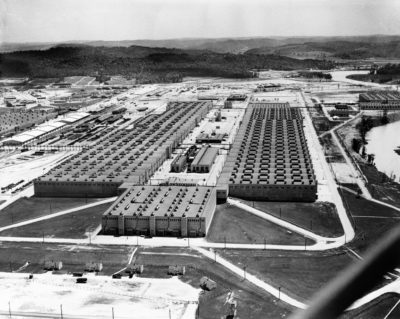Project Showcase: Revisiting the dawn of the atomic age
16 November 2018 – Ray Smith

Gladys Owens (right) and other calutron operators. Photo credit: Ed Westcott, American Museum of Science and Energy (AMSE)
Inside the City of Oak Ridge, Tennessee, you’ll find the just-opened American Museum of Science and Energy (AMSE). Part of the Manhattan Project National Historical Park, the museum examines the sites, people, events, science, and engineering of the dawn of the atomic age. A new national park is not something that happens every day. It was formed to communicate the Manhattan Project’s significance to the history of science and innovation, as well as broader American history.
The “Secret City” was built for one purpose: to generate the material needed for an atomic bomb, namely an isotope of uranium known as U-235 produced through an enrichment process. Since the science was so new, there was no way to know which enrichment method would prove most efficient. At AMSE, visitors learn that the government tried various methods at Oak Ridge, building several distinct production sites, each with a different method for producing nuclear material and each with a random codename: Y-12, K-25, S-50, and X-10.
At Y-12, an electromagnetic separation process “enriched” uranium by separating uranium-235 from the larger, more abundant uranium-238 isotope. The Y-12 plant used calutrons. These machines had to be monitored closely by calutron operators. Their only responsibility was to keep the meter’s reading as near to a designated point as they could. If the reading drifted, they were to adjust knobs on the control panel to return the meter to the designated point. The operators were never told why they had to do this; they just knew it was important for the war effort.
Visitors to AMSE hear the stories of calutron operators such as Gladys Owens. Owens was not out of high school in Kentucky for long when a friend wrote her a letter from Tennessee, informing her of a new army base that was hiring. Owens came down to Oak Ridge in December 1944 and was promptly hired at Y-12. Owens was one of many women who later became affectionately known as the “Calutron Girls.” The museum features a calutron panel from Y-12 that was used by these women.

K25 Plant. Photo credit: AMSE
Inside AMSE visitors also learn about the efforts to create the K-25 plant, an over 1.5 million square foot building that would enrich uranium using a gaseous diffusion process. The four-story, U-shaped structure measured nearly a mile from end to end. It became the world’s largest building under one roof, and it was so big its employees had to ride bikes to get from one side to the other.
Built in 1943, the X-10 Graphite Reactor served as a pilot plant for plutonium production. AMSE’s exhibits detail how workers inserted metal cylinders of uranium, called slugs, into the X-10 Graphite Reactor where a radiation process would occur. The slugs would later be extracted and taken to a chemical processing facility to retrieve the rare plutonium needed for the war. Museum visitors can view some of the machinery used inside the reactor chamber.

Handling “slugs.” Photo credit: Ed Westcott, AMSE
The visual narrative of the Manhattan Project comes to life through the museum’s collection of the photography of Ed Westcott. Without his work, much of the story would be incomplete, leaving a great void in the history of Oak Ridge during World War II. Westcott was twenty years old when he was chosen to be the only photographer allowed in Oak Ridge’s government facilities during the war. He recorded the equipment, secret operations, and groundbreaking science taking place during the Manhattan Project, as well as daily activities in the rapidly growing city.
Because of its rich history, Oak Ridge is a prime destination for science and heritage tourism. AMSE’s exceptional collections and engaging exhibitions offer visitors an immersive experience that illuminates both the scientific innovations of the atomic age and the human stories of the people who made the Manhattan Project possible.
~ Ray Smith currently serves as historian for the City of Oak Ridge, Tennessee. Having retired from the Y-12 National Security Complex as a historian in 2017, Smith ensures that current and future generations can learn about the heritage, history, and ongoing and planned activities in the City of Oak Ridge.




Excellent article. So interesting!